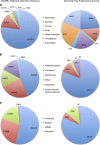A large-scale crop protection bioassay data set
- PMID: 26175909
- PMCID: PMC4493826
- DOI: 10.1038/sdata.2015.32
A large-scale crop protection bioassay data set
Abstract
ChEMBL is a large-scale drug discovery database containing bioactivity information primarily extracted from scientific literature. Due to the medicinal chemistry focus of the journals from which data are extracted, the data are currently of most direct value in the field of human health research. However, many of the scientific use-cases for the current data set are equally applicable in other fields, such as crop protection research: for example, identification of chemical scaffolds active against a particular target or endpoint, the de-convolution of the potential targets of a phenotypic assay, or the potential targets/pathways for safety liabilities. In order to broaden the applicability of the ChEMBL database and allow more widespread use in crop protection research, an extensive data set of bioactivity data of insecticidal, fungicidal and herbicidal compounds and assays was collated and added to the database.
Conflict of interest statement
Syngenta is a commercial organization involved in crop protection research and development.
Figures


Dataset use reported in
- doi: 10.1093/nar/gkt1031
References
Data Citations
-
- Gaulton A. 2014. ChEMBL. http://dx.doi.org/10.6019/CHEMBL.database.19 - DOI
References
-
- Dimova D., Stumpfe D. & Bajorath J. Systematic assessment of coordinated activity cliffs formed by kinase inhibitors and detailed characterization of activity cliff clusters and associated SAR information. Eur. J. Med. Chem. 90, 414–427 (2015). - PubMed
Publication types
MeSH terms
Substances
Grants and funding
LinkOut - more resources
Full Text Sources
Other Literature Sources

